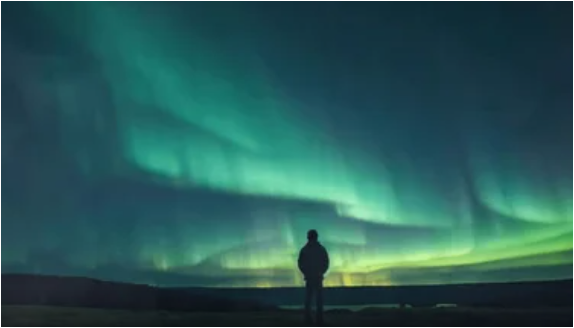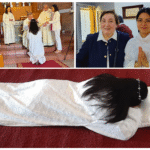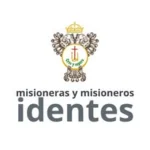
Gospel according to Saint Matthew 2:1-12:
When Jesus was born in Bethlehem of Judea, in the days of King Herod, behold, magi from the east arrived in Jerusalem, saying, “Where is the newborn king of the Jews? We saw his star at its rising and have come to do him homage.” When King Herod heard this, he was greatly troubled, and all Jerusalem with him. Assembling all the chief priests and the scribes of the people, he inquired of them where the Messiah was to be born. They said to him, “In Bethlehem of Judea, for thus it has been written through the prophet: ‘And you, Bethlehem, land of Judah, are by no means least among the rulers of Judah; since from you shall come a ruler, who is to shepherd my people Israel.’”
Then Herod called the magi secretly and ascertained from them the time of the star’s appearance. He sent them to Bethlehem and said, “Go and search diligently for the child. When you have found him, bring me word, that I too may go and do him homage.”
After their audience with the king they set out. And behold, the star that they had seen at its rising preceded them, until it came and stopped over the place where the child was. They were overjoyed at seeing the star, and on entering the house they saw the child with Mary his mother. They prostrated themselves and did him homage. Then they opened their treasures and offered him gifts of gold, frankincense, and myrrh. And having been warned in a dream not to return to Herod, they departed for their country by another way.
Missing stars.
Luis CASASUS President of the Idente Missionaries
Rome, January 05, 2025 | Epiphany of the Lord.
Is 60: 1-6; Eph 3: 2-3a.5-6; Mt 2: 1-12 or: Sirach 24: 1-2.8-12; Eph 1: 3-6.15-18; Jn 1: 1-18
Not all dioceses celebrate Epiphany today, with the figure of the Magi. In other places, the Sunday Gospel is dedicated to contemplate the person of St. John the Baptist. But what do the three Wise Men of the East and St. John have in common? Above all, they are chosen as precious instruments to make Christ known. He did not want to present himself with some flashy gesture, but through human beings as different as Mary and Joseph, those three traveling Magi and the ascetic who cries out in the desert, dressed and fed with extreme sobriety.
The Epiphany or Manifestation of Christ has several moments in his life. One, of course, is the revelation that we could call “physical”, when the Magi, representatives of the Gentiles, recognize the Incarnate Messiah. Another moment, which we commemorate next Sunday, is the Baptism of Christ, where Gentiles and Jews recognized him as Son.
In reality, the life of Christ was a continuous Epiphany, a necessary manifestation of his true identity, for they mistook him for a ghost, for Jeremiah, for Elijah, or for a resurrected John the Baptist….
For us, a first practical conclusion may be that we are also clumsy when it comes to contemplating the person of Jesus, and it happens to us as it did to the first disciples at the Transfiguration: He whom they had seen and heard every day, appeared before them, showing what was his deep and filial relationship with the Father and his union with the venerated figures of Moses and Elijah. It is not only a matter of giving Jesus an appropriate name, such as Incarnate Word, Light of the World, Son of God…but of following the exhortation of the Father to James, Peter and John on Mount Tabor: Listen to Him!….
Indeed, he always has something to say to us, not only through his words and deeds in the Gospel, and not exclusively in moments of difficult moral decisions, but, let us say it this way, without our having asked him anything. It is enough that we do not quench or repress our thirst for perfection, that we do not cease to consider ourselves small, that we do not disguise or disguise our weaknesses.
Let us remember, for example, the case of St. Augustine. It was simply being faithful to his desire for faith and truth that allowed him to receive the trigger for his conversion, the experience of ‘tolle, lege‘.
From the neighboring garden he heard a boy’s voice saying ‘Tolle, lege; tolle, lege‘ (Take and read). At first he thought it might be mere child’s play, then it occurred to him that it might be a message from God. Augustine, as if following an order, took the codex of the Apostle Paul, which his friend Alypius had left, opened it and read Romans 13: 13ff. He relates in his Confessions: I did not want to read any more, nor was it necessary. At once, as soon as I finished reading this passage, I felt as if a light of assurance had been poured into my heart, driving away all the darkness of my doubt. After this, he left everything and gave his life to God.
As Benedict XVI once recalled: Like the Magi, each person has two great “books” that provide the signs to guide his or her pilgrimage: the book of creation and the book of Sacred Scripture.
The great Johannes Kepler (1571-1630), German astronomer, when the immense stellar worlds began to be discovered, already said, enthusiastically, like a prophet among the wise: The day is imminent when it will be given to us to read God in the book of nature with the same clarity with which we read him in the Holy Scriptures and to contemplate joyfully the harmony of both revelations.
Of course, “the book of creation” is not only the stars, the sunsets and the flowers, but everything that God tells us personally, through the events of each day, we would say better, of each instant, like those words that Augustine thought he heard.
In Laudato si’, Pope Francis reminds us that human life is based on three fundamental and closely intertwined relationships: with God, with our neighbor and with the earth itself (LS, 66). No one but the three Magi paid attention to the star…And they also heeded the dream that advised them not to return to visit Herod. That makes us think that there are many subtle signs to which we do not pay attention, largely because we have our “plan of conversation” with Him, our requests – surely altruistic – and our own dreams, which may be spiritual, but are too “ours”. As a result, there are too many missing stars…
Some of you may remember this legend:
A generous woman had a dream in which Christ announced His next, immediate visit. She, after arranging the house and making her prayers with more enthusiasm than ever, sat down on the front porch with a book, so as not to keep the one who was to arrive waiting. A few minutes later, a young couple appeared, noticed her and asked her for some fruit (no money! they warned) for the child the mother was carrying. The woman, annoyed and not wanting to be distracted from the expected visit, dismissed them with a gesture and thought: Let’s see when these young and healthy people get a decent job!
That night, she dreamed again of Jesus and complained that he had not kept his promise. The answer was: I came to greet you, moreover, accompanied by my family, but you were in your thoughts.
Our Father Founder, Fernando Rielo, taught us to pay attention to prophetic signs, which are true signals on our personal path, showing us the direction we should take. These signs can come from simple or very striking events, from small experiences, from noticing a person, from an idea that catches our attention… all these are lights, small stars that really show us the way continuously, not for “humanity”, but for our personal life.
—ooOoo—
Jesus, who called himself the Good Shepherd, allowed some shepherds to collaborate in the Epiphany of Jesus, bringing the good news to the people of Bethlehem. Perhaps some of them were not exemplary, nor virtuous, for Christ had already spoken of the malice of the shepherds, both the leaders and the professional shepherds, whose intention was to steal and who were ready to abandon the sheep in a situation of danger. But, although they were not perfect, nor trained in any distinguished profession, Providence chose them to reveal who the newborn Child was.
The same thing happened to St. John the Baptist, who, besides living humbly, made every effort to divert attention from himself, thus unveiling the personality of Christ.
He said: I baptize only with water; but there is one among you – whom you do not recognize – whom I am not worthy to untie the straps of his sandals. John could not have mentioned a more menial office. Untying the straps of sandals was slave labor. There was a rabbinical saying that a disciple could do for his master everything a servant did… except untie his sandals. It was too menial a service even for a disciple.
So John meant to say, one is coming whose slave I am not even worthy to be.
Let us remember that each week, in our Examination of Perfection, we share our experience of Transfigurative Union, that is, how the Holy Spirit has increased our faith, hope and charity, especially with his gifts of wisdom, fortitude and piety. That increase is a form of the intimate Epiphany, of the Manifestation that Christ carries out in each one of us so that we may know Him better, so that we may contemplate Him united with the Father and the Holy Spirit, so that we do not lose sight of the fact that He never was and never is alone, never ceased to ask the Father what His will was, and always allowed himself to be led by the Spirit, unexpectedly, walking docilely wherever the breeze took him, just as his true disciples did later, as Philip did when he went to baptize the Ethiopian minister, as Peter also obeyed when he was led to baptize the centurion Cornelius (Acts 10).
May our disposition be like this, aware that unexpectedly, undeservedly, we are called to proclaim Christ with ever greater clarity, with new details that the gifts received engrave in our way of walking.
—ooOoo—
The star and the Eucharist. The star of Bethlehem, in addition to its profound poetic and spiritual meaning, maintains its reality in our days; Christ has left us a sensitive, visible sign that brings us ever closer to him: The Eucharist. And, more than a sign, it is His real presence.
The Eucharist, the source and summit of our Christian life (Lumen Gentium: 11), is that powerful star that continues to attract and enlighten Christians like the one that attracted and drew the Magi to Christ himself. The visible sign of this star is the tabernacle of every Church. That is why there is always a light shining wherever there is a tabernacle. It is telling us that Christ is here truly, really, substantially present in the flesh, both in body and blood, soul and divinity.
That is why, in every liturgy, we find what the Magi found centuries ago. As we walk down the aisle to receive Holy Communion, we realize that we come empty-handed, unlike the Magi of old. We carry no gifts of gold, frankincense or myrrh. We offer only our poor devotion and our good intentions, and we realize that this is never enough for the One whom we hail as the King of Kings, the Lord of Lords. But in that way, as St. John Mary Vianney, the Parish Priest of Ars, tells us: When we return from the balustrade of the altar, we are as happy as the Magi would have been if they had been able to take the Child Jesus with them.
Like the Magi, who fell on their knees and paid homage to the Child Jesus, our hearts also kneel before our Lord Jesus Christ, God, hidden in humanity and under the appearance of Bread and Wine. Having received Him in Holy Communion, we always renew the joy of the Epiphany.
_______________________________
In the Sacred Hearts of Jesus, Mary and Joseph,
Luis CASASUS
President













